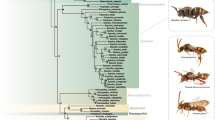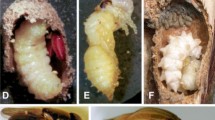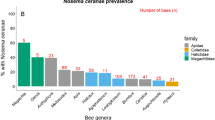Summary
The body size of the host insect in which a parasitoid develops can have important effects on its development and life history. Large and small host body size have both been suggested to be advantageous to parasitoids, depending on the life-history of the species concerned. We test field data on the bumblebeeBombus terrestris and its conopid parasitoids for evidence of differences in size between parasitised and unparasitised worker bees. Bees acting as hosts for conopid parasitoids are on average larger-bodied than unparasitised bees. This result holds for bees collected in two different years, and whether bees are collected while foraging or from the nest. The results we present demonstrate differential parasitism of hosts of different body sizes, but do not necessarily indicate active host choice by conopids. However, they are in agreement with independent evidence that conopids develop more successfully in large-than in small-bodied hosts.
Similar content being viewed by others
References
Alford, D. V., 1975.Bumblebees. Davies-Poynter, London.
van Alphen, J. J. M. and R. A. B. Drijver, 1982. Host selection byAsobara tabida Nees (Bracon-idae; Alysiinae), a larval parasitoid of fruit inhabitingDrosophila species. I. Host stage selection withDrosophila melanogaster as hosts species.Neth. J. Zool. 32:194–214.
Blumberg, D. and P. DeBach, 1981. Effects of temperature and host age upon the encapsulation ofMetaphycus stanleyi andMetaphycus helvolus eggs by brown soft scaleCoccus hesperidium.J. Invert. Path. 37:351–359.
Godfray, H. C. J., 1994.Parasitoids, Behavioral and Evolutionary Ecology. Princeton University Press, Princeton, New Jersey.
Jackson, D. J., 1958. Observations on the biology ofCaraphractus cinctus Walker (Hymenoptera, Mymaridae), a parasite of the eggs of Dytiscidae I. Methods of rearing and numbers bred on different host eggs.Trans. R. Ent. Soc. Lond. 110:533–566.
King, B. H., 1987. Offspring sex ratios in parasitoid wasps.Q. Rev. Biol. 62:367–396.
Knee, W. J. and J. T. Medler, 1965. The seasonal size increase of bumblebee workers (Hymenoptera: Bombus).Can. Entomol. 97:1149–1155.
Kouamé, K. L. and M. Mackauer, 1991. Influence of aphid size, age and behaviour on host choice by the parasitoid waspEphedrus californicus: A test of host-size models.Oecologia 88:197–203.
Pouvreau, A., 1974. Les enemies des bourdons II. Organismes affectant les adultes.Apidologia 5:39–62.
Salt, G., 1941. The effects of hosts upon their insect parasites.Biol. Rev. 16:239–264.
Salt, G., 1968. The resistance of insect parasitoids to the defence reactions of their hosts.Biol. Rev. 43:200–232.
Schmid-Hempel, P. and R. Schmid-Hempel, 1988. Parasitic flies (Conopidae, Diptera) may be important stress factors for the ergonomics of their bumblebee host.Ecol. Ent. 13:469–472.
Schmid-Hempel, P., C. Müller, R. Schmid-Hempel and J. A. Shykoff, 1990. Frequency and ecological correlates of parasitism by conopid flies (Conopidae, Diptera) in population of bumblebees.Ins. Soc. 37:14–30.
Schmid-Hempel, R., 1994. Evolutionary ecology of a host-parasitoid interaction. Ph.D. thesis, University of Basel, Switzerland.
Schmid-Hempel, R. and P. Schmid-Hempel, 1996. Larval developmental of two parasitic flies (Conopidae) in the common hostBombus pascuorum. Ecol. Ent. (in press).
Schmidt, G. T., 1974. Host-acceptance behaviour ofCampoletis sonorensis towardHeliothis zea.Ann. Ent. Soc. Amer. 67:835–844.
Vinson, S. B. and G. F. Iwantsch, 1980. Host suitability for insect parasitoids.Annu. Rev. Ent. 25:397–419.
Visser, M. E., 1994. The importance of being large: the relationship between size and fitness in females of the parasitoidAphaereta minuta (Hymenoptera: Braconidae).J. Anim. Ecol. 63:963–978.
Wilson, D. D., R. L. Ridgway and S. B. Vinson, 1974. Host acceptance and oviposition behaviour of the parasitoidCampoletis sonorensis (Hymenoptera: Ichneumonidae).Ann. Ent. Soc. Amer. 67:271–274.
Author information
Authors and Affiliations
Corresponding author
Rights and permissions
About this article
Cite this article
Müller, C.B., Blackburn, T.M. & Schmid-Hempel, P. Field evidence that host selection by conopid parasitoids is related to host body size. Ins. Soc 43, 227–233 (1996). https://doi.org/10.1007/BF01242924
Received:
Revised:
Accepted:
Issue Date:
DOI: https://doi.org/10.1007/BF01242924




